-
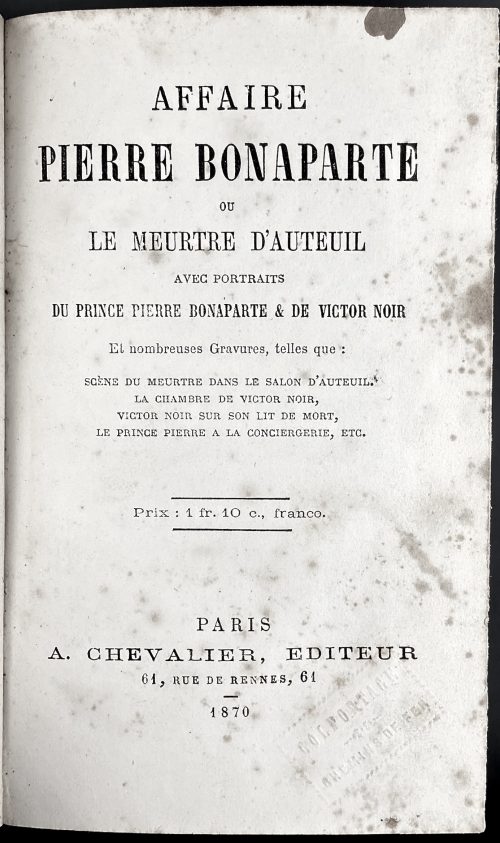 Description: 12mo, 17 x 11 cm, quarter brown morocco over marbled boards, marbled end-papers, raised bands and gilt lettering to spine, embossed stamp to t.p. “COLPORTAGE CHEMIN DE FER”. Title-page: AFFAIRE | PIERRE BONAPARTE | OU | LE MEURTRE D'AUTEUIL | AVEC PORTRAITS | DU PRINCE PIERRE BONAPARTE & DE VICTOR NOIR | Et nombreuses Gravures, telles que : | SCÈNE DU MEURTRE DANS LE SALON D'AUTEUIL. | LA CHAMBRE DE VICTOR NOIR, | VICTOR NOIR SUR SON LIT DE MORT, | LE PRINCE PIERRE A LA CONCIERGERIE, ETC. | — | Prix : 1 fr. 10 c., franco. | — | PARIS | A. CHEVALIER, EDITEUR | 61, RUE DE RENNES, 61 | 1870. Collation: 18mo; odd [1]-918; 5 x 18 = 90 leaves total. Pagination: [2] [3] 4-177 [178]; total 180 pages. Contributors: Armand Le Chevalier (French, 1802 – 1873) – publisher. Prince Pierre-Napoléon Bonaparte (French, 1815 – 1881) – character. Victor Noir [b. Yvan Salmon] (French-Jewish, 1848 – 1870) – character.
Description: 12mo, 17 x 11 cm, quarter brown morocco over marbled boards, marbled end-papers, raised bands and gilt lettering to spine, embossed stamp to t.p. “COLPORTAGE CHEMIN DE FER”. Title-page: AFFAIRE | PIERRE BONAPARTE | OU | LE MEURTRE D'AUTEUIL | AVEC PORTRAITS | DU PRINCE PIERRE BONAPARTE & DE VICTOR NOIR | Et nombreuses Gravures, telles que : | SCÈNE DU MEURTRE DANS LE SALON D'AUTEUIL. | LA CHAMBRE DE VICTOR NOIR, | VICTOR NOIR SUR SON LIT DE MORT, | LE PRINCE PIERRE A LA CONCIERGERIE, ETC. | — | Prix : 1 fr. 10 c., franco. | — | PARIS | A. CHEVALIER, EDITEUR | 61, RUE DE RENNES, 61 | 1870. Collation: 18mo; odd [1]-918; 5 x 18 = 90 leaves total. Pagination: [2] [3] 4-177 [178]; total 180 pages. Contributors: Armand Le Chevalier (French, 1802 – 1873) – publisher. Prince Pierre-Napoléon Bonaparte (French, 1815 – 1881) – character. Victor Noir [b. Yvan Salmon] (French-Jewish, 1848 – 1870) – character. -
 Series: Pictures Associated with the Iroha Syllabary [伊呂波画合]. Artist: Utagawa Kuniyoshi [歌川 國芳] (1798 – 1861). Signed: Ichiyûsai Kuniyoshi giga [一勇斎 國芳戯画] (Playfully drawn by Ichiyūsai Kuniyoshi) in a red double-gourd cartouche with a kiri-mon seal beneath. Publisher: Iseya Ichiemon [伊勢屋市右衛門] (Japanese, fl. 1823 – c. 1864); seal [辻] (Marks 16-029 | 143a). Single nanushi censor seal: Mura [村] = Murata Sahei [村田佐右衛] (VI/1842 – V/1846). Media: Fan print (uchiwa-e, 団扇絵), 231 x 296 mm. Theme: The Treasury of Loyal Retainers [仮名手本忠臣蔵] (Kanadehon Chūshingura) – an 11-act puppet play composed in 1748, based on a historical event. "Most historians now agree that there were forty-seven rōnin of Ako who attacked and killed Kira Yoshinaka (吉良 義央, 1641 – 1703) in Edo in the twelfth month of 1702, twenty-two months after their lord Asano Naganori (浅野 長矩, 1667 – 1701) had been put to death for his own failed attempt on Kira’s life". [Henry D. SMITH II. The Trouble with Terasaka: The Forty-Seventh Rōnin and the Chūshingura Imagination / Japan Review, 2004, 16:3-65]. The reader shall remember that the fictional, romantic version of the Akō incident [赤穂事件] (Akō jiken) may not (and most probably does not) reflect the historical truth of events. Uncut fan print depicting a beautiful young woman covering another woman's mouth with a blue striped cloth, possibly an obi. The picture on the wall represents the scene from the final act of The Treasury of Loyal Retainers (Kanadehon Chūshingura, Act 11) when 47 loyal retainers (rōnin) of the late lord En'ya Hangan came to the house of Kō no Moronao in order to avenge their dead master. The leader of 47 rōnin, Ōboshi Yuranosuke, divided his accomplices into several groups which attacked the Moronao mansion from different directions. To coordinate the attack and keep communication among the groups, the rōnin were signing the first syllables of their names in the hiragana syllabary. There are two major types of the ordering of the hiragana syllabary, the Gojūon one and the Iroha order (pangram poem), the latter being used here. The number of avengers exactly matches the 47 letters of that syllabary. The group entering Moronao's house from the front gate was 'chi-ri-nu-ru-wo-wa-ka'. Yoshida Sadaemon Kanesada [葦田貞右衛門兼貞] (1675 – 1703) depicted on this fan print belongs to this group. The character on the lantern hanging from Yoshida's spear reads Chū [忠] – for Chūshingura. Alternating black and white triangles on the picture frame allude to the 'signature' 47 ronin's uniform. This motif is usually described as a zigzag pattern [雁木模様] (gangi moyō), a mountain-shaped pattern [山形模様] (yamagata moyō), or a mountain road [山道] (yamamichi). The rōnin were allegedly wearing this uniform in imitation of firefighters. The government allowed the firefighters alone to gather in large groups and carry equipment akin to that of the military. Such equipment was necessary for firemen to tear down the burning buildings to stop the flames. The design can be seen in Kunimaru's fan print [SVJP-0233.2018] in this collection.Fighting Moronao's guards, the 47 rōnin entered the mansion and searched for their enemy but in vain. Finally, Yazama Jujiro Motooki [矢間重次郎元興] found the villain in the charcoal chamber and called his friends. This is the exact moment we see in the picture on the wall: Yoshida entering the charcoal chamber with a spear in his hand amid falling baskets and charcoal. Kō no Moronao was brought to justice and beheaded; his head was offered before the memorial tablet of En'ya Hangan to appease his spirit. After that, Ōboshi Yuranosuke and his 46 friends committed seppuku. They were buried at Sengakuji (泉岳寺) – a small temple near Shinagawa in Edo (Tokyo).
Series: Pictures Associated with the Iroha Syllabary [伊呂波画合]. Artist: Utagawa Kuniyoshi [歌川 國芳] (1798 – 1861). Signed: Ichiyûsai Kuniyoshi giga [一勇斎 國芳戯画] (Playfully drawn by Ichiyūsai Kuniyoshi) in a red double-gourd cartouche with a kiri-mon seal beneath. Publisher: Iseya Ichiemon [伊勢屋市右衛門] (Japanese, fl. 1823 – c. 1864); seal [辻] (Marks 16-029 | 143a). Single nanushi censor seal: Mura [村] = Murata Sahei [村田佐右衛] (VI/1842 – V/1846). Media: Fan print (uchiwa-e, 団扇絵), 231 x 296 mm. Theme: The Treasury of Loyal Retainers [仮名手本忠臣蔵] (Kanadehon Chūshingura) – an 11-act puppet play composed in 1748, based on a historical event. "Most historians now agree that there were forty-seven rōnin of Ako who attacked and killed Kira Yoshinaka (吉良 義央, 1641 – 1703) in Edo in the twelfth month of 1702, twenty-two months after their lord Asano Naganori (浅野 長矩, 1667 – 1701) had been put to death for his own failed attempt on Kira’s life". [Henry D. SMITH II. The Trouble with Terasaka: The Forty-Seventh Rōnin and the Chūshingura Imagination / Japan Review, 2004, 16:3-65]. The reader shall remember that the fictional, romantic version of the Akō incident [赤穂事件] (Akō jiken) may not (and most probably does not) reflect the historical truth of events. Uncut fan print depicting a beautiful young woman covering another woman's mouth with a blue striped cloth, possibly an obi. The picture on the wall represents the scene from the final act of The Treasury of Loyal Retainers (Kanadehon Chūshingura, Act 11) when 47 loyal retainers (rōnin) of the late lord En'ya Hangan came to the house of Kō no Moronao in order to avenge their dead master. The leader of 47 rōnin, Ōboshi Yuranosuke, divided his accomplices into several groups which attacked the Moronao mansion from different directions. To coordinate the attack and keep communication among the groups, the rōnin were signing the first syllables of their names in the hiragana syllabary. There are two major types of the ordering of the hiragana syllabary, the Gojūon one and the Iroha order (pangram poem), the latter being used here. The number of avengers exactly matches the 47 letters of that syllabary. The group entering Moronao's house from the front gate was 'chi-ri-nu-ru-wo-wa-ka'. Yoshida Sadaemon Kanesada [葦田貞右衛門兼貞] (1675 – 1703) depicted on this fan print belongs to this group. The character on the lantern hanging from Yoshida's spear reads Chū [忠] – for Chūshingura. Alternating black and white triangles on the picture frame allude to the 'signature' 47 ronin's uniform. This motif is usually described as a zigzag pattern [雁木模様] (gangi moyō), a mountain-shaped pattern [山形模様] (yamagata moyō), or a mountain road [山道] (yamamichi). The rōnin were allegedly wearing this uniform in imitation of firefighters. The government allowed the firefighters alone to gather in large groups and carry equipment akin to that of the military. Such equipment was necessary for firemen to tear down the burning buildings to stop the flames. The design can be seen in Kunimaru's fan print [SVJP-0233.2018] in this collection.Fighting Moronao's guards, the 47 rōnin entered the mansion and searched for their enemy but in vain. Finally, Yazama Jujiro Motooki [矢間重次郎元興] found the villain in the charcoal chamber and called his friends. This is the exact moment we see in the picture on the wall: Yoshida entering the charcoal chamber with a spear in his hand amid falling baskets and charcoal. Kō no Moronao was brought to justice and beheaded; his head was offered before the memorial tablet of En'ya Hangan to appease his spirit. After that, Ōboshi Yuranosuke and his 46 friends committed seppuku. They were buried at Sengakuji (泉岳寺) – a small temple near Shinagawa in Edo (Tokyo).
Utagawa Kunimaru. Chūshingura, Act 11.
 Another fan print from the same series can be found at Kuniyoshi Project:
Another fan print from the same series can be found at Kuniyoshi Project:
 The same subject is portrayed by Kuniyoshi in the series Mirror of the True Loyalty of the Faithful Retainers [誠忠義臣鏡] (Seichû gishin kagami), publisher: Kagiya Hanjirô, c. 1851 (Kuniyoshi Project) – Yoshida Sadaemon Kanesada (葦田貞右衛門兼貞) raising his sword amid falling baskets and charcoal:
The same subject is portrayed by Kuniyoshi in the series Mirror of the True Loyalty of the Faithful Retainers [誠忠義臣鏡] (Seichû gishin kagami), publisher: Kagiya Hanjirô, c. 1851 (Kuniyoshi Project) – Yoshida Sadaemon Kanesada (葦田貞右衛門兼貞) raising his sword amid falling baskets and charcoal:

-
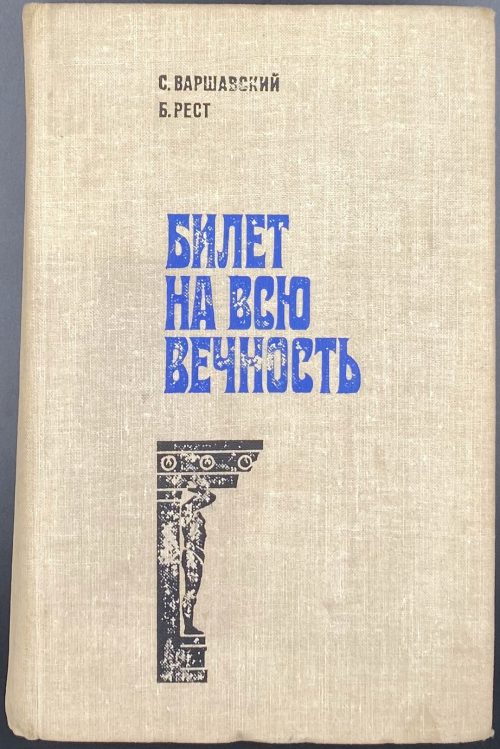 A book about the history and collections of The Hermitage museum in St. Petersburg during the October revolution of 1917. Hardcover, collated 16mo, 20,7 x 13.5 cm, grey cloth, black and blue lettering to front, blue lettering to spine, blue endpapers; collation: [1]8 2-1616 (total 248 leaves); pp.: [2] 3-493 [3] (total 496 pages) plus frontispiece. 1st edition (lifetime). Title-page: С. ВАРШАВСКИЙ | Б. РЕСТ | БИЛЕТ | НА ВСЮ | ВЕЧНОСТЬ | ПОВЕСТЬ | ОБ ЭРМИТАЖЕ | ЛЕНИЗДАТ • 1978 || Sergei Petrovich Varshavsky [Сергей Петрович Варшавский] (Jewish-Russian, 1906 – 1980). B. Rest [Б. Рест; Юлий Исаакович Шапиро] (Jewish-Russian, fl. 1940 – 1980). Борис Борисович Пиотровский (Russian, 1908 – 1990).
A book about the history and collections of The Hermitage museum in St. Petersburg during the October revolution of 1917. Hardcover, collated 16mo, 20,7 x 13.5 cm, grey cloth, black and blue lettering to front, blue lettering to spine, blue endpapers; collation: [1]8 2-1616 (total 248 leaves); pp.: [2] 3-493 [3] (total 496 pages) plus frontispiece. 1st edition (lifetime). Title-page: С. ВАРШАВСКИЙ | Б. РЕСТ | БИЛЕТ | НА ВСЮ | ВЕЧНОСТЬ | ПОВЕСТЬ | ОБ ЭРМИТАЖЕ | ЛЕНИЗДАТ • 1978 || Sergei Petrovich Varshavsky [Сергей Петрович Варшавский] (Jewish-Russian, 1906 – 1980). B. Rest [Б. Рест; Юлий Исаакович Шапиро] (Jewish-Russian, fl. 1940 – 1980). Борис Борисович Пиотровский (Russian, 1908 – 1990). -
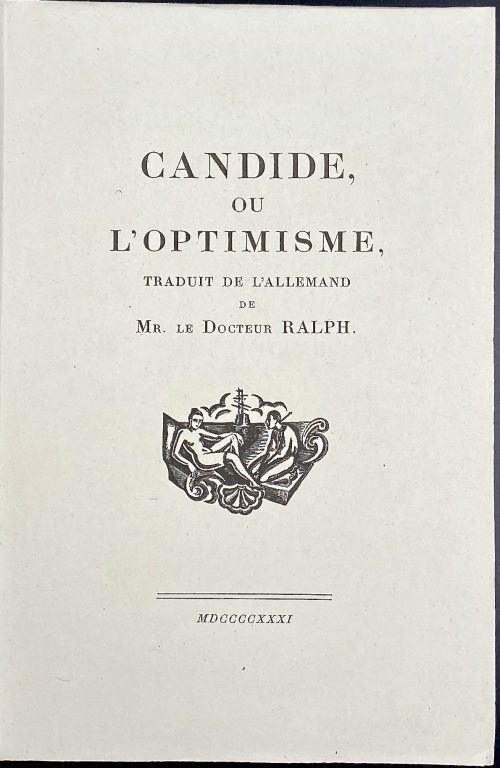 Softcover, 26 x 16.5 cm, publisher’s grey wrappers lettered in black, unbound, in a green double slipcase; collated in-4to, 24 leaves folded in four, pp.: [8] [1] 2-174 [10], total 192 pages, ils. Title-page: CANDIDE, | OU L’OPTIMISME, | TRADUIT DE L’ALLEMAND | DE | Mr. le Docteur RALPH. | {fleuron} | — | MDCCCCXXXI || Collation: π4 1-214 222 22*4 χ2, total 96 leaves, all on laid paper but χ (Avis au relieur) on Arches wove paper (watermarked) plus frontispiece and 12 engraved plates after Jean Roy. Limited edition of 300 copies — 5 on Chine, 10 on Japon, and the rest (275) on Arches, not for sale; of which this is copy № 3, numbered and signed by the artist ‘au crayon rouge’. Catalogue raisonné: Dutel 1137. Contributors: François-Marie Arouet [Voltaire] (French, 1694 – 1778) – author. Jean Roy – artist; attributed by most to Marcel North (British-Swiss, 1909 – 1990), and by J.P. Dutel to Edy Legrand (French, 1892 – 1970).
Softcover, 26 x 16.5 cm, publisher’s grey wrappers lettered in black, unbound, in a green double slipcase; collated in-4to, 24 leaves folded in four, pp.: [8] [1] 2-174 [10], total 192 pages, ils. Title-page: CANDIDE, | OU L’OPTIMISME, | TRADUIT DE L’ALLEMAND | DE | Mr. le Docteur RALPH. | {fleuron} | — | MDCCCCXXXI || Collation: π4 1-214 222 22*4 χ2, total 96 leaves, all on laid paper but χ (Avis au relieur) on Arches wove paper (watermarked) plus frontispiece and 12 engraved plates after Jean Roy. Limited edition of 300 copies — 5 on Chine, 10 on Japon, and the rest (275) on Arches, not for sale; of which this is copy № 3, numbered and signed by the artist ‘au crayon rouge’. Catalogue raisonné: Dutel 1137. Contributors: François-Marie Arouet [Voltaire] (French, 1694 – 1778) – author. Jean Roy – artist; attributed by most to Marcel North (British-Swiss, 1909 – 1990), and by J.P. Dutel to Edy Legrand (French, 1892 – 1970). -
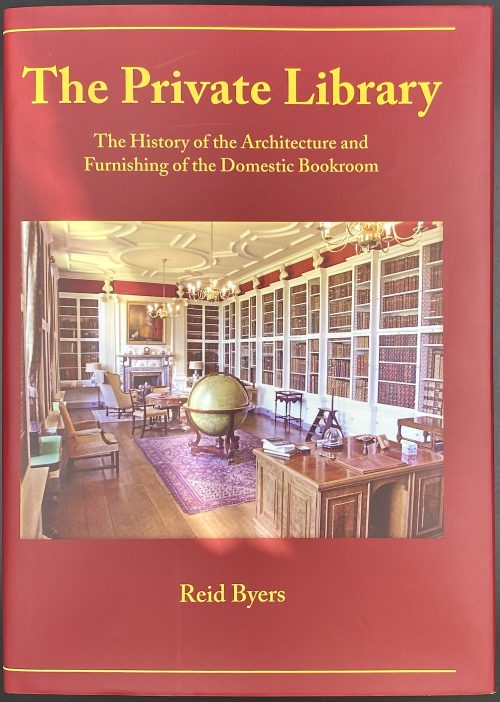 Hardcover, 28 x 19 cm, black cloth with gilt lettering to spine, red pictorial dust jacket; pp.: [i-vii] viii-x [2] [1] 2-540 [8], total 560 pages, profusely illustrated. Title-page: The private library | ~ | Being a More or Less Compendious Disquisition | on | The History of the Architecture and | Furnishing of the Domestic Bookroom | ☙ ❧ | Reid Byers | {publisher’s device} | New Castle, Delaware | 2021 || ISBN: 9781584563884 Author: Reid Byers (American).
Hardcover, 28 x 19 cm, black cloth with gilt lettering to spine, red pictorial dust jacket; pp.: [i-vii] viii-x [2] [1] 2-540 [8], total 560 pages, profusely illustrated. Title-page: The private library | ~ | Being a More or Less Compendious Disquisition | on | The History of the Architecture and | Furnishing of the Domestic Bookroom | ☙ ❧ | Reid Byers | {publisher’s device} | New Castle, Delaware | 2021 || ISBN: 9781584563884 Author: Reid Byers (American). -
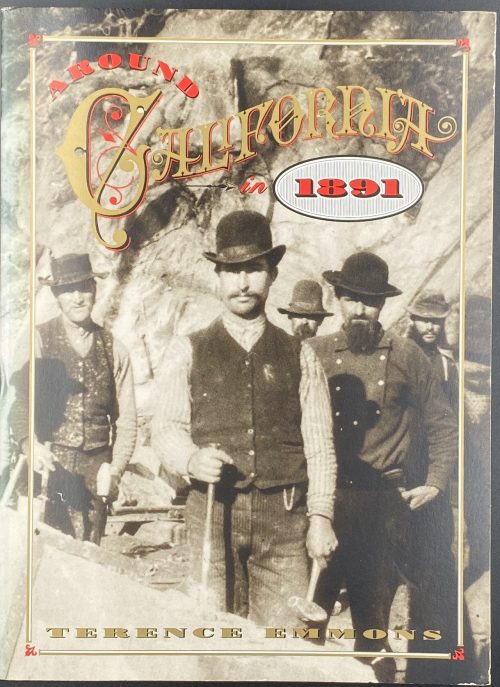 Softcover, 22.5 x 16.5 cm, pictorial paperback, pp.: [i-xi] xii-xix [xx blank] [2] [1] 2-179 [180] [6 advert.], total 206 pp plus cardstock Portable Stanford form. Nicholas Russel [Николай Константинович Судзиловский] (Russian-American, 1850 – 1930)
Softcover, 22.5 x 16.5 cm, pictorial paperback, pp.: [i-xi] xii-xix [xx blank] [2] [1] 2-179 [180] [6 advert.], total 206 pp plus cardstock Portable Stanford form. Nicholas Russel [Николай Константинович Судзиловский] (Russian-American, 1850 – 1930) -
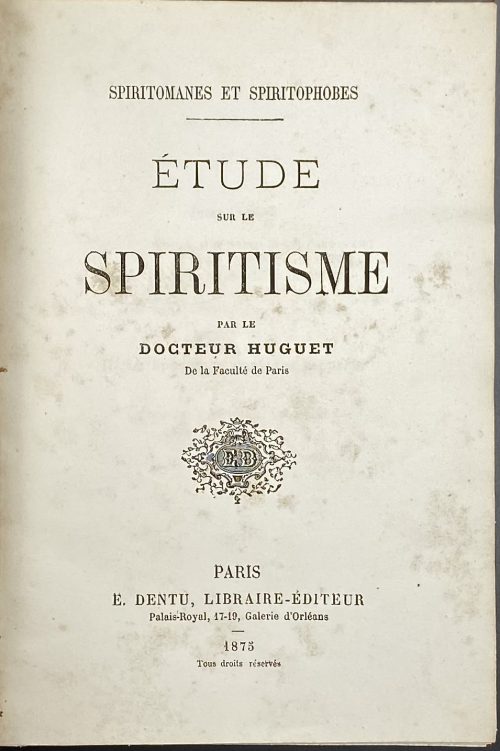 Hardcover volume 20 x 14 cm, bound in burgundy half faux chagrin over brown faux chagrin boards, gilt lettering to spine, marbled endpapers, all margins sprinkled blue. Convolute: 1) SPIRITOMANES ET SPIRITOPHOBES |— | ÉTUDE | SUR LE | SPIRITISME | PAR LE | DOCTEUR HUGUET | De la Faculté de Paris | {« ED » publsiher’s device} | PARIS | E. DENTU, LIBRAIRE-ÉDUTEUR | Palais-Royal, 17-19, Galerie d’Orléans | – | 1875 | Tous droits réservés ||; pp. [1-7] 8-48, with Dr Huguet signature to h.t. verso. Contents: Introduction. I. Le procès du 16 juin 1875; MM. Firman, Buguet, Leymarie. II. Le Spiritisme dans ses rapports avec le dogme, l’histoire, la science. Conclusion. 2) Same, pp. [1-7] 8-48, with Dr Huguet signature to h.t. verso. 3) FÉDÉRATION SPIRITE BELGE | — | Étude critique | DU LIVRE INTITULÉ | L'Hypnotisme | et le Spiritisme | du Docteur Joseph LAPPONI | Médecin de L. L. S. S. LÉON XIII et PIE X. | * | CONFÉRENCE | PAR | J. FRAIKIN | Président de la Fédération Spirite de Liége, | Vice-Président de la Fédération Spirite Belge. | * | Imp. Emile Dumon | Rue Haute-Marexhe, 27, Herstal-Liége. ||; pp. [1-3] 4-50 [51] errata/blank. 4) BUREAU PERMANENT D’ÉTUDE | DES | PHÉNOMÈNES SPIRITES | ANVERS | * | Cours De Doctrine Spirite | — | Imprimerie et Publicité « LA GÉNÉRALE » (SOC. AN.) Anvers. ||; 6 leaves, pagination trimmed out with partly visible numbers 13 and 18 ; includes Deuxième leçon « Du passage de la vie… », t.p., 7 pp. of text, last three pages blank. 5) LA PSYCHOLOGIE EXPERIMENTALE || Manifeste adresse par le « Syndicat de la Presse spiritualiste de France » | au Congres spiritualiste de Londres (Juin 1898); pp. [1] 2-31 [32]. Contents: I. Prolégomènes. II. Télépathie. III. Médiumnité. Conclusion. 6) LE FLUIDE HUMAIN | Son existence/ | Ses lois * Ses propriétés | — | CONFÉRENCE | DONNÉE PAR LE | Sous-Lieutenant DE BACKERE | — ||; pp. [1-3] 4-28. Contributors: Hilarion Huguet (French, ? – ?) Alfred-Henri Firman (American, ? – ?) Édouard Isidore Buguet (1840 – 1901) Pierre-Gaëtan Leymarie (1827 – 1901) Giuseppe Lapponi (Italian, 1851 – 1906) Jacques Fraikin (Belgian, ? – ?) Franz de Backere (Belgian, ? – ?)
Hardcover volume 20 x 14 cm, bound in burgundy half faux chagrin over brown faux chagrin boards, gilt lettering to spine, marbled endpapers, all margins sprinkled blue. Convolute: 1) SPIRITOMANES ET SPIRITOPHOBES |— | ÉTUDE | SUR LE | SPIRITISME | PAR LE | DOCTEUR HUGUET | De la Faculté de Paris | {« ED » publsiher’s device} | PARIS | E. DENTU, LIBRAIRE-ÉDUTEUR | Palais-Royal, 17-19, Galerie d’Orléans | – | 1875 | Tous droits réservés ||; pp. [1-7] 8-48, with Dr Huguet signature to h.t. verso. Contents: Introduction. I. Le procès du 16 juin 1875; MM. Firman, Buguet, Leymarie. II. Le Spiritisme dans ses rapports avec le dogme, l’histoire, la science. Conclusion. 2) Same, pp. [1-7] 8-48, with Dr Huguet signature to h.t. verso. 3) FÉDÉRATION SPIRITE BELGE | — | Étude critique | DU LIVRE INTITULÉ | L'Hypnotisme | et le Spiritisme | du Docteur Joseph LAPPONI | Médecin de L. L. S. S. LÉON XIII et PIE X. | * | CONFÉRENCE | PAR | J. FRAIKIN | Président de la Fédération Spirite de Liége, | Vice-Président de la Fédération Spirite Belge. | * | Imp. Emile Dumon | Rue Haute-Marexhe, 27, Herstal-Liége. ||; pp. [1-3] 4-50 [51] errata/blank. 4) BUREAU PERMANENT D’ÉTUDE | DES | PHÉNOMÈNES SPIRITES | ANVERS | * | Cours De Doctrine Spirite | — | Imprimerie et Publicité « LA GÉNÉRALE » (SOC. AN.) Anvers. ||; 6 leaves, pagination trimmed out with partly visible numbers 13 and 18 ; includes Deuxième leçon « Du passage de la vie… », t.p., 7 pp. of text, last three pages blank. 5) LA PSYCHOLOGIE EXPERIMENTALE || Manifeste adresse par le « Syndicat de la Presse spiritualiste de France » | au Congres spiritualiste de Londres (Juin 1898); pp. [1] 2-31 [32]. Contents: I. Prolégomènes. II. Télépathie. III. Médiumnité. Conclusion. 6) LE FLUIDE HUMAIN | Son existence/ | Ses lois * Ses propriétés | — | CONFÉRENCE | DONNÉE PAR LE | Sous-Lieutenant DE BACKERE | — ||; pp. [1-3] 4-28. Contributors: Hilarion Huguet (French, ? – ?) Alfred-Henri Firman (American, ? – ?) Édouard Isidore Buguet (1840 – 1901) Pierre-Gaëtan Leymarie (1827 – 1901) Giuseppe Lapponi (Italian, 1851 – 1906) Jacques Fraikin (Belgian, ? – ?) Franz de Backere (Belgian, ? – ?) -
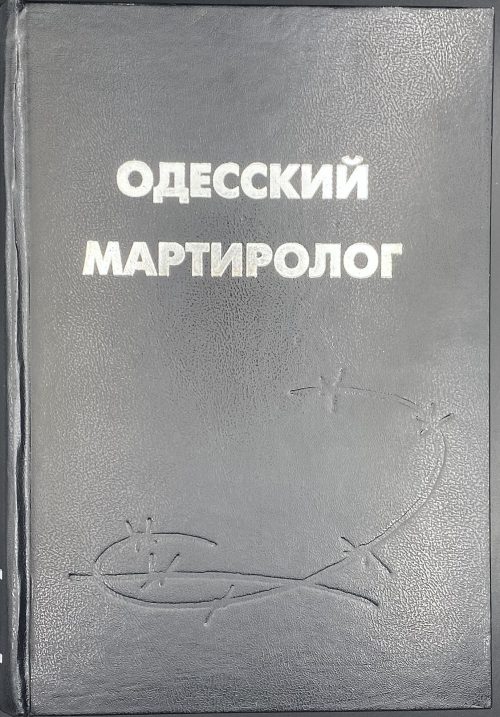 Hardcover volume, 24.3 x 17.3 cm, bound in black buckram with blind barbed wire design and silver lettering to front cover and spine, pp.: [2] 3-959 [960]. Одеський мартиролог: Данi про репресованих Одеси i Одеськоï областi за роки радянськоï влады (Серiя «Реабiлiтованi iсторiэю») (Том 4) / Уклад.: Л. В. Ковальчук, Г. О. Разумов— Одеса: СМИЛ, 2006. Title-page: Научно-документальная серия книг | «РЕАБИЛИТИРОВАННЫЕ ИСТОРИЕЙ» | ОДЕССКИЙ | МАРТИРОЛОГ | ТОМ 4 | Одесса | СМИЛ | 2006 || ISBN: 966-8127-63-3 Print run: 1,000 copies. Ковальчук, Лидия Всеволодовна Разумов, Георгий Александрович
Hardcover volume, 24.3 x 17.3 cm, bound in black buckram with blind barbed wire design and silver lettering to front cover and spine, pp.: [2] 3-959 [960]. Одеський мартиролог: Данi про репресованих Одеси i Одеськоï областi за роки радянськоï влады (Серiя «Реабiлiтованi iсторiэю») (Том 4) / Уклад.: Л. В. Ковальчук, Г. О. Разумов— Одеса: СМИЛ, 2006. Title-page: Научно-документальная серия книг | «РЕАБИЛИТИРОВАННЫЕ ИСТОРИЕЙ» | ОДЕССКИЙ | МАРТИРОЛОГ | ТОМ 4 | Одесса | СМИЛ | 2006 || ISBN: 966-8127-63-3 Print run: 1,000 copies. Ковальчук, Лидия Всеволодовна Разумов, Георгий Александрович -
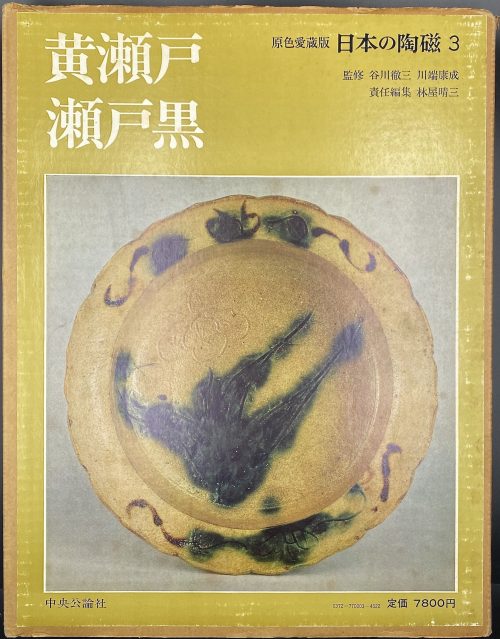 Hardcover volume, 35.3 x 27 cm, bound in grey cloth, blind stamped characters to front, brown characters to spine, in a glassine dust jacket, in a double slipcase, the outer case pictorial paper over cardboard, 36 x 28 cm, pp.: [4] [1] 2-88 (plates with photographs of 129 items), [2] 91-108 [3]. Seto ware [瀬戸焼] (Seto-yaki) – ceramics produced in and around the city of Seto in Aichi Prefecture. Yellow seto [黄瀬戸] (Kiseto) – a yellow glaze seto ware. Black seto [瀬戸黒] (Setoguro) – a black glaze seto ware. 日本の陶磁 – Japanese ceramics, series title. Contributors: Yasunari Kawabata [川端 康成] (Japanese, 1924 – 1972) – author. Tetsuzo Tanikawa [谷川 徹三] (Japanese, 1895 – 1989) – author. Seizo Hayashiya [林屋晴三] (Japanese, 1928 – 2017) – editor. Chūōkōron-sha [中央公論社] – publisher.
Hardcover volume, 35.3 x 27 cm, bound in grey cloth, blind stamped characters to front, brown characters to spine, in a glassine dust jacket, in a double slipcase, the outer case pictorial paper over cardboard, 36 x 28 cm, pp.: [4] [1] 2-88 (plates with photographs of 129 items), [2] 91-108 [3]. Seto ware [瀬戸焼] (Seto-yaki) – ceramics produced in and around the city of Seto in Aichi Prefecture. Yellow seto [黄瀬戸] (Kiseto) – a yellow glaze seto ware. Black seto [瀬戸黒] (Setoguro) – a black glaze seto ware. 日本の陶磁 – Japanese ceramics, series title. Contributors: Yasunari Kawabata [川端 康成] (Japanese, 1924 – 1972) – author. Tetsuzo Tanikawa [谷川 徹三] (Japanese, 1895 – 1989) – author. Seizo Hayashiya [林屋晴三] (Japanese, 1928 – 2017) – editor. Chūōkōron-sha [中央公論社] – publisher. -
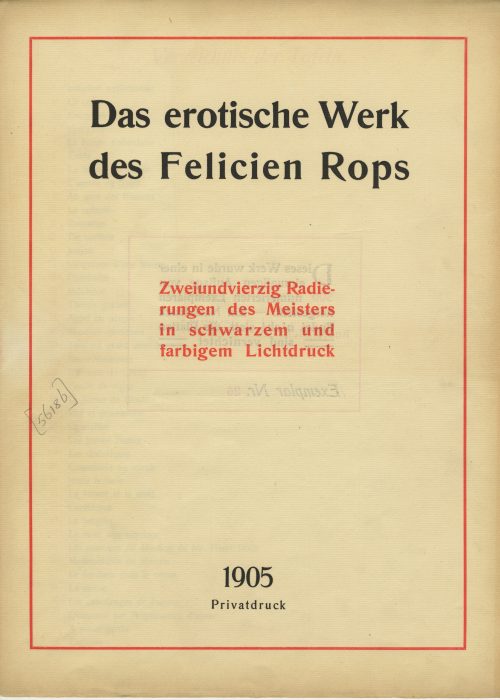
A limited-edition (№26/500) set of 42 etchings and drypoints after Félicien Rops (Belgian, 1833 – 1898), each mounted in a numbered passe-partout, printed posthumously by an anonym in Germany in 1905; in a flapped half faux suede-backed cardboard portfolio with straps, 442 x 335 mm, red embossed lettering to the front cover, bookplate of Richard Teschner (Austrian, 1879 – 1948) pasted inside.
Title-page (in a red frame): Das erotische Werk | des Felicien Rops | Zweiundvierzig Radie- | rungen des Meisters | in schwarzem und | farbigem Lichtdruck | 1905 | Privatdruk ||
Limitation (in a red two-section frame) : Dieses Werk wurde in einer | einmaligen Auflage von | 500 numerierten Exemplaren | hergestellt. — Ein Nachdruck | findet nicht statt, die Platten | == sind vernichtet == | Exemplar Nr. 26 ||
Verzeichnis der Tafeln (Table of Contents): 1. Initiation sentimentale; 2. La croix; 3. Entre-acte; 4. Holocauste; 5. La bonne hollandaise; 6. Étude; 7. La femme au pantin; 8. L’amour de Satan; 9. Au pays des féminies; 10. La volupté; 11. Evocation; 12. De castitate; 13. Joujou; 14. Vengeance d’une femme; 15. Phantasies; 16. Indolence; 17. Théâtre gaillard; 18. Appel au peuple; 19. Masques modernes; 20. Tout est grand chez les rois; 21. Marie-Madeleine; 22. L’amante du Christ; 23. Feuille de vigne; 24. La messe de Guide; 25 Viol et prostitution; 26. Le maillot; 27. Les jeunes France; 28. Les diaboliques; 29. Coquetterie au miroir; 30. Jeune homme; 31. La femme et la mort; 32. Confidence; 33. La bergère; 34. La mère aux satyrions; 35. Les exercices de dévotion de Mr. Henri Roch; 36. Mademoiselle de Maupin; 37. Le bonheur dans le crime; 38. La sirène; 39. Les cabotinages de l’amour; 40. Document sur l’impuissance d’aimer; 41. A cœur perdu; 42. Curieuse.
-
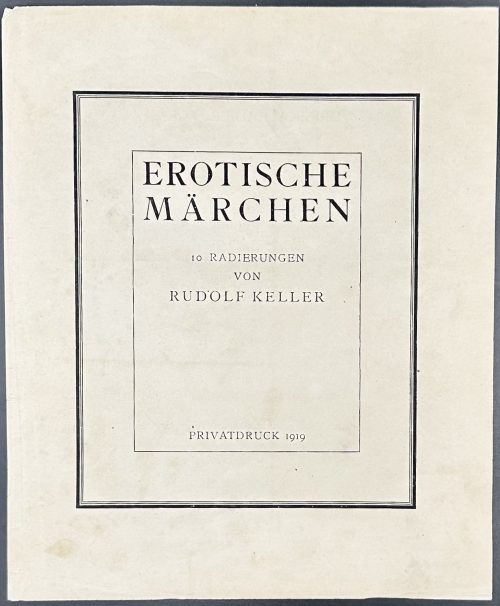 Portfolio 265 x 225 mm, black half-buckram over diapered cardboard with flaps, black with gilt lettering in frame to front “R. KELLER | MÄRCHEN”, t.p. printed on wave paper, the folder and engravings printed on laid paper, 10 loose plates, 240 x 210 mm sheet, 135 x 110-115 mm plate; re-issue of ten plates of the first edition of 16 plates published in Austria in c. 1910s. Title-page: EROTISCHE | MÄRCHEN | 10 RADIERUNGEN | VON | RUDOLF KELLER | PRIVATDRUCK 1919 || Die Mappe enthält folgende originalradierungen: 1. Aschenbrödel; 2. Dornröschen; 3. Zwerg Nase; 4. Froschkönig; 5. Der gestiefelte Kater; 6. Hänsel und Gretel; 7. Der fliegende Koffer; 8. Schneewittchen mit den 7 Zwergen; 9. Die kleine Seejungfer; 10. Der kleine Daumling Dieses Werk wurde in einer einmaligen Auflage von 250 numerierten Exemplaren hergestellt und darf nur an Gelehrte und Sammler abgegeben werden. Die Platten wurden vernichtet. Nr. 1—50 sind vom Künstler signierte Vorzugsdrucke. Dieses Exemplar erhielt Nr. 0153. Translation: The folder contains the following original etchings: 1. Cinderella; 2. Sleeping Beauty; 3. Dwarf nose; 4. The Frog Prince; 5. Puss in Boots; 6. Hansel and Gretel; 7. The Flying Trunk; 8. Snow White with the Seven Dwarfs; 9. The Little Mermaid; 10. Little Thumbling. This work was produced in a one-time edition of 250 numbered copies and may only be sold to scholars and collectors. The copperplates were destroyed. Nos. 1-50 are special prints signed by the artist. This copy was given number 0153. Seller's description: Erotische Märchen. S.l., Privatdruck, 1919. In-8, en feuilles, sous chemise demi-chagrin vert recouverte de papier japonais. Recueil de 10 eaux-fortes originales de Rudolf Keller. Ces eaux-fortes érotiques dans les teintes brunes s'inspirent des contes de fées traditionnels comme Cendrillon, La Belle au bois dormant, Hansel et Gretel, Blanche-Neige, Le Petit Poucet etc. Tirage à 250 exemplaires. Chemise défraîchie. Jacob Grimm (German; 1785 – 1863) Wilhelm Grimm (German, 1786 – 1859) Charles Perrault (French, 1628 – 1703) Hans Christian Andersen (Danish, 1805 – 1875)
Portfolio 265 x 225 mm, black half-buckram over diapered cardboard with flaps, black with gilt lettering in frame to front “R. KELLER | MÄRCHEN”, t.p. printed on wave paper, the folder and engravings printed on laid paper, 10 loose plates, 240 x 210 mm sheet, 135 x 110-115 mm plate; re-issue of ten plates of the first edition of 16 plates published in Austria in c. 1910s. Title-page: EROTISCHE | MÄRCHEN | 10 RADIERUNGEN | VON | RUDOLF KELLER | PRIVATDRUCK 1919 || Die Mappe enthält folgende originalradierungen: 1. Aschenbrödel; 2. Dornröschen; 3. Zwerg Nase; 4. Froschkönig; 5. Der gestiefelte Kater; 6. Hänsel und Gretel; 7. Der fliegende Koffer; 8. Schneewittchen mit den 7 Zwergen; 9. Die kleine Seejungfer; 10. Der kleine Daumling Dieses Werk wurde in einer einmaligen Auflage von 250 numerierten Exemplaren hergestellt und darf nur an Gelehrte und Sammler abgegeben werden. Die Platten wurden vernichtet. Nr. 1—50 sind vom Künstler signierte Vorzugsdrucke. Dieses Exemplar erhielt Nr. 0153. Translation: The folder contains the following original etchings: 1. Cinderella; 2. Sleeping Beauty; 3. Dwarf nose; 4. The Frog Prince; 5. Puss in Boots; 6. Hansel and Gretel; 7. The Flying Trunk; 8. Snow White with the Seven Dwarfs; 9. The Little Mermaid; 10. Little Thumbling. This work was produced in a one-time edition of 250 numbered copies and may only be sold to scholars and collectors. The copperplates were destroyed. Nos. 1-50 are special prints signed by the artist. This copy was given number 0153. Seller's description: Erotische Märchen. S.l., Privatdruck, 1919. In-8, en feuilles, sous chemise demi-chagrin vert recouverte de papier japonais. Recueil de 10 eaux-fortes originales de Rudolf Keller. Ces eaux-fortes érotiques dans les teintes brunes s'inspirent des contes de fées traditionnels comme Cendrillon, La Belle au bois dormant, Hansel et Gretel, Blanche-Neige, Le Petit Poucet etc. Tirage à 250 exemplaires. Chemise défraîchie. Jacob Grimm (German; 1785 – 1863) Wilhelm Grimm (German, 1786 – 1859) Charles Perrault (French, 1628 – 1703) Hans Christian Andersen (Danish, 1805 – 1875) -
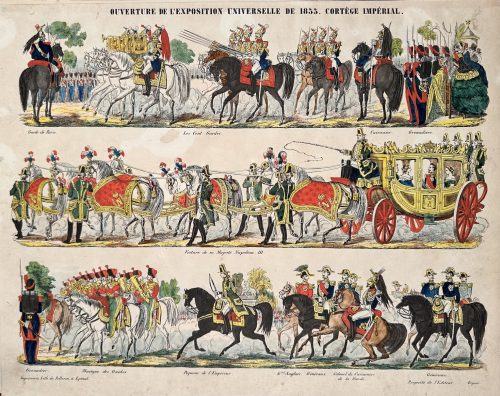 Hand-coloured woodcut on wove paper, 366 x 460 mm; black ink stamp “5057” to reverse. Caption cartoon in 2 tiers. Top: OUVERTURE DE 'EXPOSITION UNIVERSELLE DE 1855. CORTÈGE IMPÉRIAL. Captions top to bottom: Garde de Paris. — Les Cent Gardes. — Cuirassier. — Grenadiers. Middle: Voiture de sa Majesté Napoléon III. | Bottom: Grenadier. — Musique des Guides. — Piqueur de l’Empereur. — Gral Anglais — Généraux — Colonel de Cuirassiers | de la Garde — Généraux. Below left: Imprimerie Lith. de Pellerin, à Épinal; right: Propriété de l’Éditeur. Déposé. Jean Charles Pellerin (French, 1756 – 1836) – printer/publisher.
Hand-coloured woodcut on wove paper, 366 x 460 mm; black ink stamp “5057” to reverse. Caption cartoon in 2 tiers. Top: OUVERTURE DE 'EXPOSITION UNIVERSELLE DE 1855. CORTÈGE IMPÉRIAL. Captions top to bottom: Garde de Paris. — Les Cent Gardes. — Cuirassier. — Grenadiers. Middle: Voiture de sa Majesté Napoléon III. | Bottom: Grenadier. — Musique des Guides. — Piqueur de l’Empereur. — Gral Anglais — Généraux — Colonel de Cuirassiers | de la Garde — Généraux. Below left: Imprimerie Lith. de Pellerin, à Épinal; right: Propriété de l’Éditeur. Déposé. Jean Charles Pellerin (French, 1756 – 1836) – printer/publisher. -
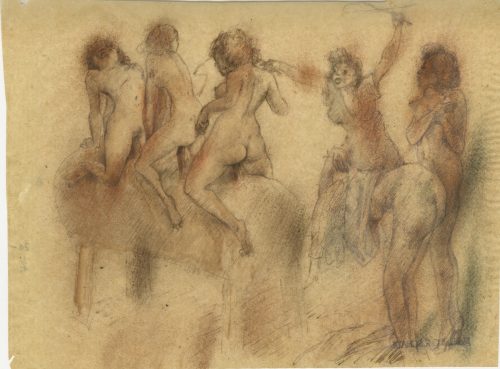 Pencil, pen and ink wash on india paper, 170 x 228 mm, black ink stamp to verso: “Nachlaß O R SCHATS”. Unsigned, attributed to Otto Rudolf Schatz (Austrian, 1900 – 1961).
Pencil, pen and ink wash on india paper, 170 x 228 mm, black ink stamp to verso: “Nachlaß O R SCHATS”. Unsigned, attributed to Otto Rudolf Schatz (Austrian, 1900 – 1961). -
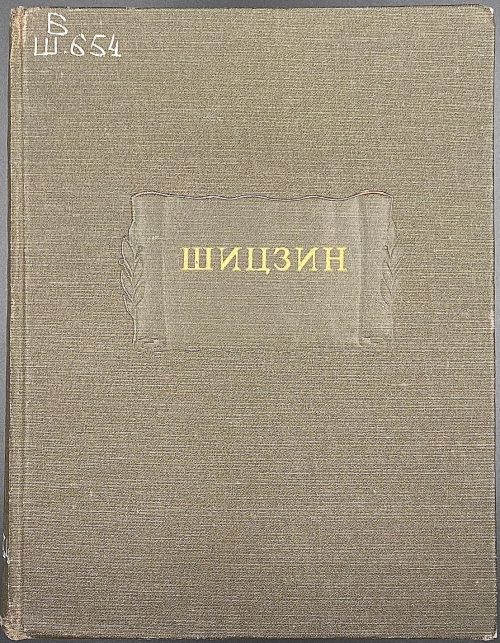 Title (black and red): ШИЦЗИН | [device} | ИЗДАНИЕ ПОДГОТОВИЛИ | А.А. ШТУКИН И Н.Т. ФЕДОРЕНКО | ИЗДАТЕЛЬСТВО АКАДЕМИИ НАУК СССР | МОСКВА | 1957 Title page verso: РЕДАКЦИОННАЯ КОЛЛЕГИЯ СЕРИИ «ЛИТЕРАТУРНЫЕ ПАМЯТНИКИ» (names) Ответственный редактор доктор филологических наук Н. Т. ФЕДОРЕНКО Поэтическая редакция А. Е. АДАЛИС Pagination: [1, 2] – serial h.t / title in Chinese 诗经, [3, 4] – t.p. / editorial board, [5, 6] – editorial / blank, [7, 8] – f.t. / blank, 9-610 [611] [612 colophon]; print run 3,500 copies. Collation: [1]8 2-398. Binding: 23 x 17.5 cm; serial green cloth blind-stamped with a scroll adorned with gold lettering to board and spine. Содержание: От редакции. — С. 5; Шицзин / Пер. A.A. Штукина: Нравы царств. — С. 7-193; Малые оды. — С. 195-325; Великие оды. — С. 327-409; Гимны. — С. 411-466. Приложения: Федоренко Н.Т. «Книга песен». — С. 469-530; Комментарии / Сост. A.A. Штукин, ред. В.А. Кривцов. — С. 531-600.
Title (black and red): ШИЦЗИН | [device} | ИЗДАНИЕ ПОДГОТОВИЛИ | А.А. ШТУКИН И Н.Т. ФЕДОРЕНКО | ИЗДАТЕЛЬСТВО АКАДЕМИИ НАУК СССР | МОСКВА | 1957 Title page verso: РЕДАКЦИОННАЯ КОЛЛЕГИЯ СЕРИИ «ЛИТЕРАТУРНЫЕ ПАМЯТНИКИ» (names) Ответственный редактор доктор филологических наук Н. Т. ФЕДОРЕНКО Поэтическая редакция А. Е. АДАЛИС Pagination: [1, 2] – serial h.t / title in Chinese 诗经, [3, 4] – t.p. / editorial board, [5, 6] – editorial / blank, [7, 8] – f.t. / blank, 9-610 [611] [612 colophon]; print run 3,500 copies. Collation: [1]8 2-398. Binding: 23 x 17.5 cm; serial green cloth blind-stamped with a scroll adorned with gold lettering to board and spine. Содержание: От редакции. — С. 5; Шицзин / Пер. A.A. Штукина: Нравы царств. — С. 7-193; Малые оды. — С. 195-325; Великие оды. — С. 327-409; Гимны. — С. 411-466. Приложения: Федоренко Н.Т. «Книга песен». — С. 469-530; Комментарии / Сост. A.A. Штукин, ред. В.А. Кривцов. — С. 531-600.(Shijing)
-
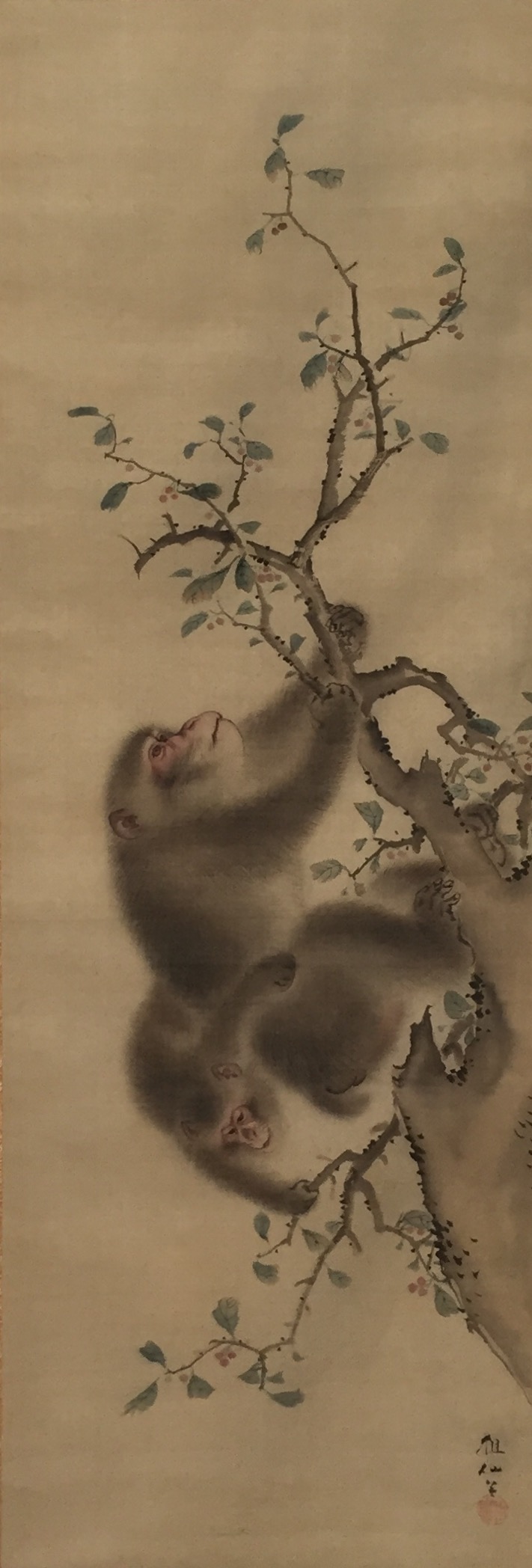 Mori Sosen (1747-1821). Two Monkeys Hanging From Branches. Hanging Scroll Painting. Ink and colour on silk. Signed: Sosen. Sealed: Sosen.
Mori Sosen (1747-1821). Two Monkeys Hanging From Branches. Hanging Scroll Painting. Ink and colour on silk. Signed: Sosen. Sealed: Sosen. -
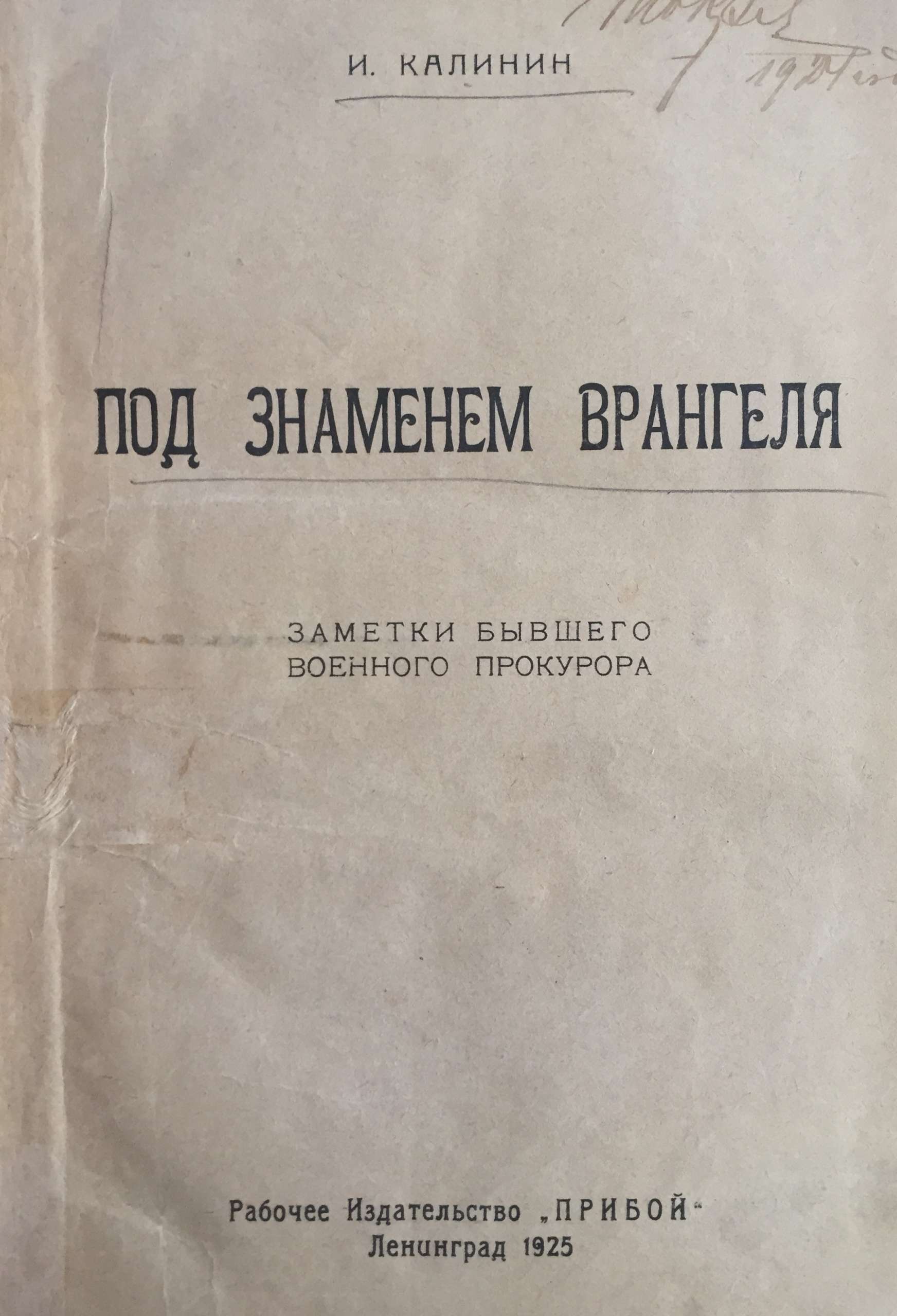
И. М. Калинин. Под знаменем Врангеля. Заметки бывшего военного прокурора. - Л.: Рабочее из-во "Прибой", 1925. - 273 с.
Тираж 7125 экз.
Об авторе: «К моменту февральской революции я занимал должность помощника военного прокурора Кавказского военно-окружного суда... Я не был политиком, но не переносил Союза русского народа. Падение монархии приветствовал. В 1917 году в г. Эрзеруме, занимая довольно приличный пост, работал в самом тесном содружестве с Советом солдатских и рабочих депутатов. Меньшевики, эсэры, большевики постоянно навещали меня, зная, что я хотя и внепартийный, но искренно предан делу революции». В 1918-м Калинину удалось перебраться в занятый Добровольческой армией Екатеринодар, откуда в конце сентября 1918 г. он выехал на Дон. «Здесь тоже мобилизовали всех офицеров. Мне ничего другого не оставалось, как поступить на службу в только что сорганизованный Донской военно-окружной суд». Будучи профессиональным военным юристом Калинин в дальнейшем состоял прокурором при временном Донском военном суде.
По возвращении из эмиграции полковник Калинин, как и многие другие репатрианты, пытался избавиться от клейма «бывшего белогвардейца». 5 октября 1937 г. И. М. Калинин, в то время преподаватель рабочего факультета Ленинградского автодорожного института, был арестован по решению Комиссии НКВД и Прокуратуры СССР . 2 ноября 1937 г. он был приговорен по ст. 58-6-8-11 УК РСФСР к высшей мере наказания и расстрелян в Ленинграде 10 ноября 1937 года.
-
 Shakudō tsuba of the slightly vertically elongated round form (nagamaru-gata) decorated by gold in flat inlay (hira-zōgan) with three insects (cricket, locust, and praying mantis), grass and dewdrops motif. Kogai hitsu-ana is plugged with gilded soft metal. Height: 70.2 mm; width: 66.4 mm x Thickness at seppa-dai: 4.5 mm. Edo period (from ca. 1700 to ca. 1850) Unsigned. Attributed to Kaga School or Murakami School. Almost identical tsuba (no dewdrops, though) is illustrated and described at page 60 of Kokusai Tosogu Kai. 7th International Convention & Exhibition, November 1st, 2011 at Tokyo National Museum, page 60. It is attributed to the Kaga School, Mid Edo period (Late 17th - early 18th century). Dimensions: 70.5 x 66 x 4.5 mm. "The rich black shakudo plate has been slightly lowered (dished out) and then polished. Gold insects crawl amongst grasses, depicted by Kaga style hirazogan (flat inlay). One tendril of the mantis overlaps onto seppa-dai. The mantis boldly looks out from the tsuba in a curious way. This style of Kaga tsuba was popular during the Genroku era (1688-1703)."Another source is Japanese Sword Fittings. A descriptive catalogue of the Collection of G.H. Naunton, Esq., completed and illustrated by Henri L. Joly, - 1912:
Shakudō tsuba of the slightly vertically elongated round form (nagamaru-gata) decorated by gold in flat inlay (hira-zōgan) with three insects (cricket, locust, and praying mantis), grass and dewdrops motif. Kogai hitsu-ana is plugged with gilded soft metal. Height: 70.2 mm; width: 66.4 mm x Thickness at seppa-dai: 4.5 mm. Edo period (from ca. 1700 to ca. 1850) Unsigned. Attributed to Kaga School or Murakami School. Almost identical tsuba (no dewdrops, though) is illustrated and described at page 60 of Kokusai Tosogu Kai. 7th International Convention & Exhibition, November 1st, 2011 at Tokyo National Museum, page 60. It is attributed to the Kaga School, Mid Edo period (Late 17th - early 18th century). Dimensions: 70.5 x 66 x 4.5 mm. "The rich black shakudo plate has been slightly lowered (dished out) and then polished. Gold insects crawl amongst grasses, depicted by Kaga style hirazogan (flat inlay). One tendril of the mantis overlaps onto seppa-dai. The mantis boldly looks out from the tsuba in a curious way. This style of Kaga tsuba was popular during the Genroku era (1688-1703)."Another source is Japanese Sword Fittings. A descriptive catalogue of the Collection of G.H. Naunton, Esq., completed and illustrated by Henri L. Joly, - 1912:
7-U17. Ron Hartmann Collection.
Kanazawa in Kaga was a centre of fine metal work during the whole of the Tokugawa period. At first the inlayers of Fushimi following the Daimyo Maeda went to Kanazawa, then some of the Gotō masters proceeded from Kyoto for short periods to work for the Daimyo, so that their influence was strongly impressed upon Kaga work..." A somewhat look-a-like tsuba is illustrated at plate XXVIII, Kaga Inlay, №653 with the following description at page 52: "Shakudō, inlaid with five insects in gold: crickets, praying mantis, grasshopper, in the style of Takagawara Ujitsugu.
According to M. Sesko, Ujitsugu was a master from Katsuki and Kaneko School in Kaga, son of Ujihira. Ujihira's father Ujiyoshi died in 1802. This brings us to the mid-19th century, instead of mid-18th or earlier. On the other hand, a very much look alike specimen at MFA collection (ACCESSION NUMBER 17.1061) has the with the following description: Edo period. Late 18th–early 19th century. Murakami School. Main material: shakudo; other metals: gold; decorative technique: iroe hirazogan.A detailed account of Murakami school can be found at The Japanese toso-kinko Schools.// Lulu Inc., 2012 by Markus Sesko, on pages 235-239. All-in-all, it's either Kaga School or Murakami School, either ca. 1700 or ca. 1850. Quite a range! SOLD
MFA # 17.1061
-
 Iron tsuba of six-lobed (mutsu-mokkō-gata) form, with six wild boar's eye shape (inome) openings (sukashi). Hitsu-ana and the entire perimeter of tsuba have typical for this school raised rim. Lobes are decorated with landscape motifs in low relief carving (sukidashi-bori). On the obverse: A hut under a full moon, Shinto shrine gates (torii) with pines and a full moon, rocks, a large pine tree, and a temple (pagoda) surrounded by rocks and waves. On the reverse: waves, fishing boat, wild gees in flight under full moon, maple, hexagon (tortoiseshell, kikko) with a dot inside and a dot outside (inclusion/exclusion symbol), and chrysanthemum (the last two may be family crests, mon). Kamakura-bori school. Late Muromachi period (1514-1573). Height: 64.2 mm, width: 74.3 mm, Thickness at seppa-dai: 3.2 mm, at rim 2.6 mm. Weight: 62.8 g (light). NBTHK old green certificate №561: Tokubetsu Kicho - "Extraordinary Work". A look-a-like tsuba can be found at the Compton Collection, part II, pp. 14-15, №17, though his tsuba is more massive (80 x 84 x 4 mm).NBTHK paper says that the motif is Hakkei (八景), i.e. "Eight Views," so several interpretations are possible (the original Chinese ones, Omi Hakkei, etc.). However, most likely it is the 'Eight views of Omi' (近江八景 - 'Omi Hakkei'). Why the artist selected a 6-lobed form for depicting 8 views remains unclear, and thus we are in our right to raise the question whether the motif is indeed Hakkei. The term Omi hakkei (eight views of Omi) refers to painting or print sets which illustrate life on the shores of Lake Biwa in Omi (now Shiga Prefecture). The model for such paintings came from China, where, from the eleventh century onward, painters had produced eight views of the Hsiao and Hsiang lake areas of Hunan Province. The themes, which follow the original Chinese models, are: geese descending to land, returning fishing boats, clearing rain, a snow-covered evening landscape, the autumn moon, night rain, a temple bell at evening, and the glow of sunset. Japanese artists have also used the eight-theme approach for other parts of country - including cities - and applied it to subject matter other than landscapes. [Merrily Baird. Symbols of Japan. Thematic motifs in art and design. Rizzoli international publications, Inc., 2001, page 308-9]. Japan Encyclopedia by Louis Frédéric also mentions Omi Hakkei as "Eight landscapes of Omi", and states that this theme was often cited in poetry after 1500. It is likely that the tsuba in focus is designed under the influence of the theme popularity in the 16th century. The theme was effectively exploited by prominent ukiyo-e artists Suzuki Harunobu and Utagawa Hiroshige in the 18th and 19th century, respectively. These are the eight scenes of the theme (see Wikipedia):
Iron tsuba of six-lobed (mutsu-mokkō-gata) form, with six wild boar's eye shape (inome) openings (sukashi). Hitsu-ana and the entire perimeter of tsuba have typical for this school raised rim. Lobes are decorated with landscape motifs in low relief carving (sukidashi-bori). On the obverse: A hut under a full moon, Shinto shrine gates (torii) with pines and a full moon, rocks, a large pine tree, and a temple (pagoda) surrounded by rocks and waves. On the reverse: waves, fishing boat, wild gees in flight under full moon, maple, hexagon (tortoiseshell, kikko) with a dot inside and a dot outside (inclusion/exclusion symbol), and chrysanthemum (the last two may be family crests, mon). Kamakura-bori school. Late Muromachi period (1514-1573). Height: 64.2 mm, width: 74.3 mm, Thickness at seppa-dai: 3.2 mm, at rim 2.6 mm. Weight: 62.8 g (light). NBTHK old green certificate №561: Tokubetsu Kicho - "Extraordinary Work". A look-a-like tsuba can be found at the Compton Collection, part II, pp. 14-15, №17, though his tsuba is more massive (80 x 84 x 4 mm).NBTHK paper says that the motif is Hakkei (八景), i.e. "Eight Views," so several interpretations are possible (the original Chinese ones, Omi Hakkei, etc.). However, most likely it is the 'Eight views of Omi' (近江八景 - 'Omi Hakkei'). Why the artist selected a 6-lobed form for depicting 8 views remains unclear, and thus we are in our right to raise the question whether the motif is indeed Hakkei. The term Omi hakkei (eight views of Omi) refers to painting or print sets which illustrate life on the shores of Lake Biwa in Omi (now Shiga Prefecture). The model for such paintings came from China, where, from the eleventh century onward, painters had produced eight views of the Hsiao and Hsiang lake areas of Hunan Province. The themes, which follow the original Chinese models, are: geese descending to land, returning fishing boats, clearing rain, a snow-covered evening landscape, the autumn moon, night rain, a temple bell at evening, and the glow of sunset. Japanese artists have also used the eight-theme approach for other parts of country - including cities - and applied it to subject matter other than landscapes. [Merrily Baird. Symbols of Japan. Thematic motifs in art and design. Rizzoli international publications, Inc., 2001, page 308-9]. Japan Encyclopedia by Louis Frédéric also mentions Omi Hakkei as "Eight landscapes of Omi", and states that this theme was often cited in poetry after 1500. It is likely that the tsuba in focus is designed under the influence of the theme popularity in the 16th century. The theme was effectively exploited by prominent ukiyo-e artists Suzuki Harunobu and Utagawa Hiroshige in the 18th and 19th century, respectively. These are the eight scenes of the theme (see Wikipedia):
Compton Collection, part II, pp. 14-15, №17: Kamakura-bori tsuba, ca. 1450.
- Returning sails at Yabase (矢橋の帰帆) - Yabase. Yabase is an old harbour on the east side of the lake. Near the Tokaido, it was used for a shortcut to Otsu by boat.
- Evening glow at Seta (勢多(瀬田)の夕照) - The Chinese Bridge at Seta. The long bridge across the Seta was used by the Tokaido. In the background the "Fuji of Omi", the Mikamiyama. It is just above 400 m, but indeed well visible.
- Autumn moon at Ishiyama (石山の秋月) - Ishiyama Temple. The Ishiyamadera was located on a hillside next to the Seta River. It got his name form the strange rocks on which it is built, partly on supporting beams. A hut at the upper end of the site allows a view of the lake, and the moon.
- Clear breeze at Awazu (粟津の晴嵐) - Awazuhara. Awazu is well known for its pine wood, Awazu-ga-hara.
- Evening bell at Miidera (三井晩鐘) - Mii-dera. Miidera temple was built in the 8th century. Its famous bell is one of the "Three bells of Japan", the other two being those at Byoodo-in, Uji and at Jingoji, Kyoto.
- Evening rain at Karasaki (唐崎の夜雨) - Karasaki Shrine. Karasaki is a small cape with a single large pine tree, a hitsu-matsu.
- Wild geese returning home at Katata (堅田の落雁) - Ukimido. Alighting geese cannot be seen always, however the little temple near Katata in the square hōkyō-style, detached from the lakeside, connected by a bridge. The first part of the name uki is the same as in Ukiyo-e, meaning floating. Midō means temple.
- Evening snow at Hira (比良の暮雪) - Hira Mountains. The Hira mountains on the west side of the lake experience the hard winter, when the winter monsoon brings much snow from the continent.


